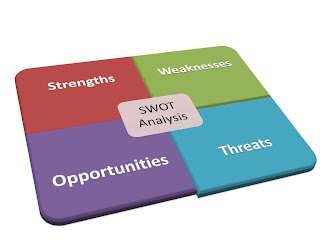WEEK
9
1. Mwailu & Mercer has described resource-based
view (RBV) as the basis for a competitive advantage of a firm lies primarily in
the application of the bundle of valuable interchangeable and intangible
tangible resources at the firm’s disposal.
Organizations may have tangible resources like
assets, human resource and capital or intangible resources like brand image,
information, culture and knowledge. These resources used in the organization
certainly have its importance but the matter of concern is how they are used.
In strategy, resource based view can be defined as the formulation of strategy
so as to gain competitive advantage over other by focusing on how efficiently
and effectively the internal resources and capabilities of the organization can
be used. Each and every organization has same or similar resources but it makes
difference depending on how they are used.
2. The analysis that can be undertaken to assess the
internal factors of an organization is known as internal strategic analysis.
Internal factors of the organizations may include resources, competences,
goals, objectives, structure, and systems and so on. These internal factors
help in identification of performance of the business according to the change
in external environment and its strategic capabilities that can be used to gain
competitive advantage.
There are different model to undertake internal
analysis of the organization:
McKinsey’s 7s model assesses all the internal
aspects of the organization. It helps in the analysis of the performance of the
organization by implementing the strategies using staffs and skills as well as
shared value. It can also identify whether the systems and structures are
compatible or not.
VRIN
Model
VRIN model helps to spot out the organization’s
strategic capabilities and key resources. After identification of these
resources and capabilities they are used in such a way so that no one can cope
and imitate it and is rare. These resources even help to gain competitive
advantage over others by forming core competences.
Value
Chain Analysis
A chain of activities starting from extraction of
raw materials to offering final products to customers is known as value chain
whereas value chain analysis is the analysis of activities that adds value
within the chain, relationships between the activities and those activities
that can be seen in terms of strengths of an organization. This analysis
divides the value chain into different groups of activities, identifies the
activities that are best and worse within the value chain and identifies
activities that give competitive advantage, value to the products and decreases
costs within the value chain of an organization and develop strategies that
best utilize these activities and other resources.
SWOT analysis helps to identify the strengths,
weaknesses, opportunities and threats of an organization. Strengths and
weaknesses of organization are identified for internal analysis whereas
opportunities and threats are identified for external analysis. It helps to
identify resources knowledge and culture of an organization which is the
strengths of an organization and these strengths can be used to grab the
opportunities in the organization’s external environment and overcome
weaknesses. It also helps to identify weaknesses which must be defeated.
Books
JohnsonG,ScholesKandWhittingtonR(2009),FundamentalsofStrategy,PrenticeHall.
LynchR(2008)StrategicManagement,5thEdition,PrenticeHall.
Reference
Books
JohnsonG,ScholesKandWhittingtonR(2009),FundamentalsofStrategy,PrenticeHall.
LynchR(2008)StrategicManagement,5thEdition,PrenticeHall.



No comments:
Post a Comment